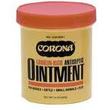Pronunciation
treye-am-SIN-oh-lone - Pronunciation guide
Brand Names
- Triamtabs
- Vetalog Parenteral Veterinary
Description
 Triamcinolone is a long-acting glucocorticoid, or hormone, that predominantly affects the metabolism of carbohydrates and, to a lesser extent, fats and proteins. It also has other effects in the horse's body.
Triamcinolone is a long-acting glucocorticoid, or hormone, that predominantly affects the metabolism of carbohydrates and, to a lesser extent, fats and proteins. It also has other effects in the horse's body.
Usage
Triamcinolone is used to treat heaves, recurrent airway obstruction, arthritis, allergic conditions, and dermatologic conditions responsive to glucocorticoids.
In all cases, a veterinarian should be consulted regarding dosage and administration.
Dosage and Administration
 Triamcinolone Triamcinolone |
||||
|---|---|---|---|---|
| Method | Dosage (click row for calculator) |
Concentration | Period | Duration |
| Subcutaneous or Intramuscular injection | 0.01-0.02 mg/lb | 2 mg/ml | One injection | NA |
| Subcutaneous or Intramuscular injection | 0.01-0.02 mg/lb | 6 mg/ml | One injection | NA |
| Intra-Articular or Intrasynovial injection | 6-18 mg | 2 mg/ml | One injection | NA |
| Intra-Articular or Intrasynovial injection | 6-18 mg | 6 mg/ml | One injection | NA |
Notes:
|
||||
Side Effects
Sodium retention, fluid retention, potassium loss, weight gain/loss, anorexia, and diarrhea are possible side effects. Anaphylactic reactions have occasionally been seen following administration.
Precautions
Do not exceed 20 mg total dose. High dosages have been associated with laminitis. Do not use in treatment of laminitis.
Do not use in animals with tuberculosis, chronic nephritis, or cushingold syndrome, except for emergency therapy. Do not administer to pregnant mares, especially during the last trimester.
Triamcinolone is FDA-approved for use in horses. It is a prescription drug and U. S. federal law restricts the use of this drug by or on the written or oral order of a licensed veterinarian.
Triamcinolone is prohibited in any drug-free competition. Check with the appropriate regulatory group.
Interactions
None noted in literature.
Overdose
Overdose will result in worsening of the side effects noted above.
Images
 Triamcinolone Injection
Triamcinolone Injection
 Triamcinolone Ointment
Triamcinolone Ointment
Literature
